The boom material used by British Petroleum to contain the massive river of oil that it flowing into the Gulf of Mexico is not working. So, ask yourself why BP is unwilling to use a product that seems far superior to the bloated, filthy, broken "sausage" absorbent boom that is washing up along miles of sensitive marshlands on the Louisiana Coast.
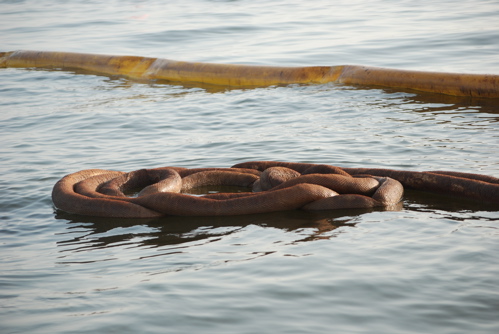
Abandoned, worthless sausage (absorbent) boom
A standard 1,000-foot roll of this new product is only six inches in diameter and requires 1/20 of the storage space required by absorbent booms currently used in the oil spill control industry. It costs pennies per foot as opposed to dollars--a thousand foot roll costs $260 instead of $10-20,000 (the price is market driven). The canister which holds the boom, which is really a thin (.0005 inches) film laminate is 20 inches in length, by 8 by 8 inches and can be deployed by a small boat or by hand in sensitive marsh areas. It does not need to be hauled or stored on huge boats or Coast Guard cutters.
The kicker is that this new product, the ROC (Rapid Oil Containment) Barrier is Coast Guard approved in San Francisco, and BP has tested it on Alaska's North slope.
Here is a story for you.
After a long day on the Gulf, witnessing the destruction of bird life and marshlands, we heard a knock at the cabin door. A friend brought a guy named Kristoffer Diel to see me.

Kristoffer Diel, AMS
Diel was pissed off and had something he wanted to show me. He plopped a container that was no bigger than a small duffel bag on the table and asked what I would say if he told me there was a thousand feet of boom material in it. Diel is a licensed marine surveyor and had come across the product three years ago at a trade show and kept the canister with him ever since. After the massive and continuing release of oil into the Gulf from BP's Transocean/ DeepwaterHorizon disaster, Diel brought the product to the attention of "incident command" in Roberts Louisiana. Turns out Diel is also the District Commander of the US Coast Guard Auxiliary, so he has an "in" or two. Well, maybe not in this case. Diel was told that the ROC Barrier Boom was not approved by the Coast Guard (it is), and that it is not on the list of BP vendors.
"The testing was approved by the Coast Guard in San Francisco, and Chevron has also done testing on it," Diel said. "There's a video. Take a look for yourself."
So we did.
Diel was not finished.
BP and the government are analogous to dinosaurs. I have been dealing with them for seven years. Their approach to any change or disaster is ruled by organizational structure. They know the boom they are using will not work. It is not designed for this. I'm a marine safety officer. I don't want people dying. I don't want wildlife dying. BP is trying to hide the spill by using dispersants and it is working. I live on a boat and you are messing with my environment. Check out the Oil Pollution Act of 1990 . You are not allowed to use dispersants. It's in the water column now and there is no getting rid of it.
Heavy stuff. Did Diel want to be quoted? "Absolutely."
I mentioned the conversation with Diel to a friend in Los Angeles who invented a high-tech bird cleaning machine that has been blocked by Tri-State, the wildlife cleaner working at Fort Jackson. Elizabeth has encountered the same bureaucratic tangle that Diel described. She immediately called Glenn Murray the owner of ROC Barrier who happened to be in Alabama demonstrating his product for WKRG television with the Gulf Coast distributor, Don White, who can be seen at the end of this video.
When Murray and White heard that BP was holding a town hall meeting in Houma on Friday night, they immediately drove to Louisiana in time to meet face-to-face with BP and Coast Guard representatives. We went along.

On the way to Grand Isle earlier in the day
BP's Hugh Depland was there to soothe fears with a tidy speech.
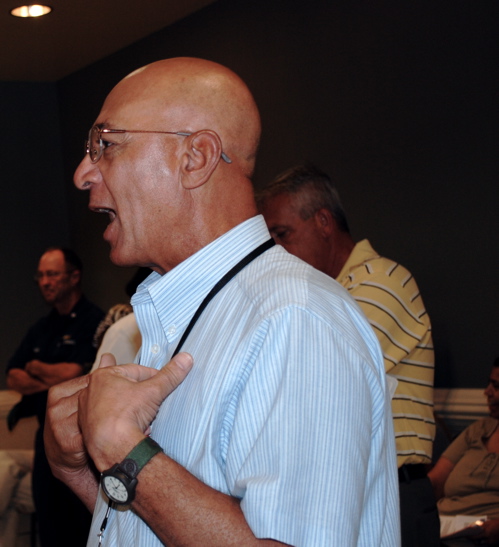
BP Representative Hugh Depland at Houma Community Meeting
We waited in line to ask him about why BP would not consider the new boom material. When he saw the camera he clammed up and said he "had to talk to someone else first." He was too busy.
Murray and White got close, but Depland chided them for trying to "be first in line."
So, we sought out the Coast Guard representative, Kurt A. Hansen, and R&D guy with the "U.S. Coast Guard Acquisition Directorate." He definitely did not like the camera, the BP oil disaster seems to have created a fear of photography down here on the Mississippi Delta, so I moved off and let White and Murray have their say. It did not go well. I asked Hansen for his card and he "did not have one," and muttered his affiliation and title.
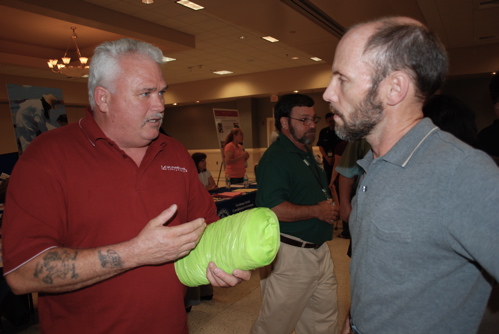
Glenn Murray trying to explain ROC Boom to Kurt A. Hansen, P.E., of the U.S. Coast Guard "Acquisition Directorate"
So much for community relations.
Murray has had email correspondence with Hansen in the past.
Hello Kurt,
With all that is happening in the Gulf, do you not believe the ROC Barrier will be a great asset there? Please if you would, let me know who I should be contacting, thinking outside the box is what is required at this point. Best Regards, Glenn Murray
Your information is on the list for consideration.
Kurt A. Hansen, P.E.
U.S. Coast Guard Acquisition Directorate
Research & Development Center
So it's on the list, even though it is not on the list.
As far as the excuse of BP not testing Murray's corporation as an approved vendor, emails once again tell a different story.
From: glenn.murray
Sent: Monday, May 17, 2010 4:01 AM
To: AK, HSSEE ER NSlope CM ER Coord
Subject: RE: ROC 9-13-09Hello Tony
I am speaking with BP and others in the Gulf of Mexico, all want to know where the ROC has been used and what the results are. Can you give me something I can show them....your thoughts and results.
Please help
Thank youGlenn Murray
Murrenhill CorporationSubject: RE: ROC 9-13-09
Date: Mon, 17 May 2010 08:58:23 -0800Glenn, The ROC was deployed for training only, I don't recall any application in an actual spill on the slope. However, I will recommend that it be used and available for protection against sheens and similar minimal depth plumes. It is useful as a rapid protection boom, but not a sorbent boom.
Do you have a reference number from the Horizon Support submission.
Ed Wieliczkiewicz
Alternate - Tony Hout
BPXA NS Crisis Management/Emergency Response Coordinator
OK. So it obvious BP and the Coast Guard are well aware of the product, despite what they told Diel when he visited "incident command."
We had another avenue open to us, and that was to test the boom on some of the crude New Orleans photographer Jerry Moran and I witnessed that was trapping oiled pelicans in Barataria Bay.
So, on Saturday we rented a boat from Captain PJ Blaize in Empire and headed out to the open Gulf in search of our Moby Dick slick.
The first challenge was not puking because of the stench of benzene. At least it was my challenge; the guys seemed to have stronger stomachs.
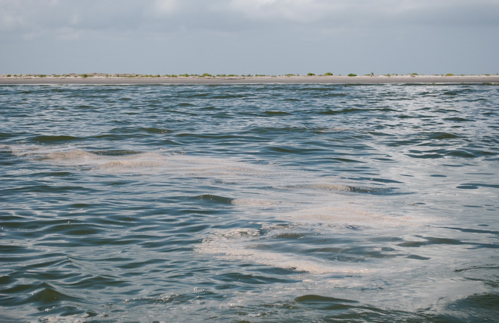
Dispersant plume and what you can't see is the stench of benzene
I told Moran I was ready to throw him overboard if he stopped to photograph one more oiled pelican, and there were many. Where were the tri-state bird people?
It seemed like forever before we encountered oil on the surface, even though we could smell it. Why?
This is the BIG LIE of COREXIT. It hides the oil in an undersea column. You can smell it, but you have to be on top of it to see it. The fish and dolphins swim through it.
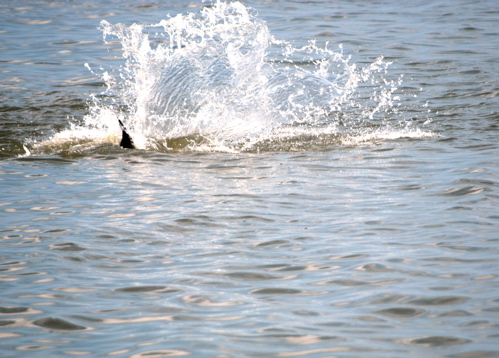
Dolphin feeding in COREXIT and oil mix
The sharks are gone. We speculated that with their superior sense of smell, they left long ago. The unfortunate dolphins feed in the lines of COREXIT, mistaking it for a tide line. When we placed some of the ROC Boom in the water, crabs immediately latched onto it, trying desperately to get out of the COREXIT/oil soup. It was, quite, frankly, disgusting, disheartening, and maddening to see this.
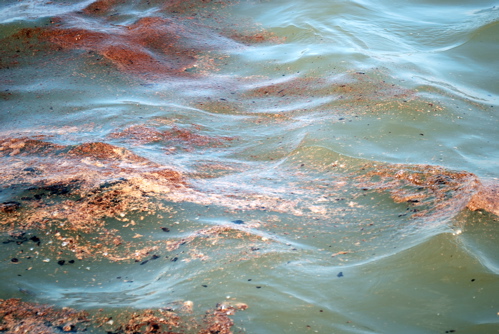
Up close
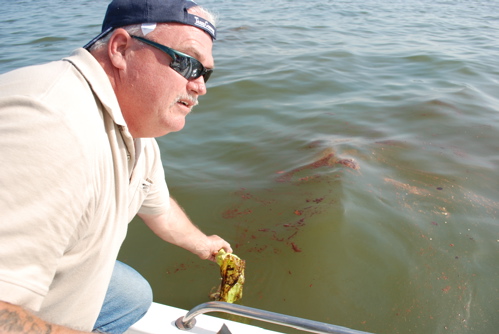
Hiding the crude--a bubbly stew of oil and COREXIT
So we never got a chance to corral some crude, but gave it a go on the oily dispersant. It worked. We took some video, and the company will make it available. The bottom line is that we deployed 800 feet in one minute and fifty-seven seconds going at a slow speed. The oil/dispersant stayed inside the barrier. After two minutes on the water the material was saturated with oil. Murray put it this way.
"You have just contained an area of crap that will hit a beach somewhere."
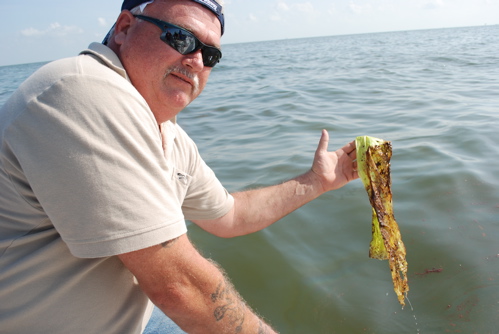
Glenn Murray dipping ROC Boom into dispersant/oil mixture
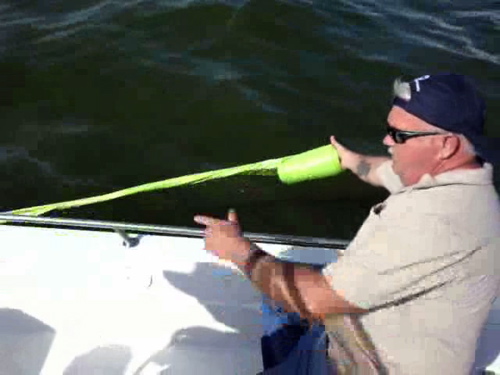
Boom deployment/Still frame from video
As the film laminate landed in the water, the friction of the water held the oil/dispersant mixture in place. While our boat circled the perimeter of the oily mixture, the film laminate continuously streamed from the dispenser and contained the mess. So, we proved that oil does adhere to the ROC Boom. The scary part is what lies below the surface.
Corexit 9527 has been designated a "chronic and acute health hazard" by the EPA. It is made with 2-butoxyethanol, a highly toxic chemical that has long been linked to the health problems of cleanup crews who worked on the Exxon Valdez spill. On the toxicity question, you could hardly find a more dangerous combination of poisons to dump into the Gulf of Mexico than what has been revealed in Corexit. The answers are currently unknown, which is exactly why it is so inexcusable that Nalco and the oil industry giants would for so long refuse to disclose the chemical ingredients they're dumping into the Gulf of Mexico in huge quantities (over a million gallons dumped into the ocean to date).
It's hard to believe this COREXIT is that bad, but I believe it now after lying in bed all day with all of the symptoms. Moran and I decided no more exposure. We are not martyrs, nor are we willing to be victims. The sea life and the people on the Gulf have no choice in the matter.
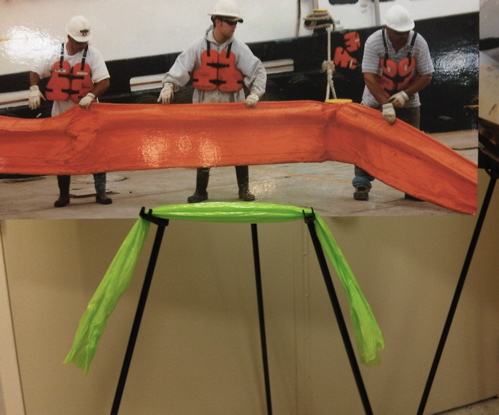
Deflective Boom vs. ROC Boom
As for BP and their spin and refusal to consider thinking outside of the box with new and better ways of mitigating the river of oil, well, Diel put it this way.
"Why bother? BP just wants it to go away. Dispersants will hide it, but it will never go away once it is in the water column."
